The Dar Parmorza – The Polish three-masted tall ship
By
Dennis C. Orvis
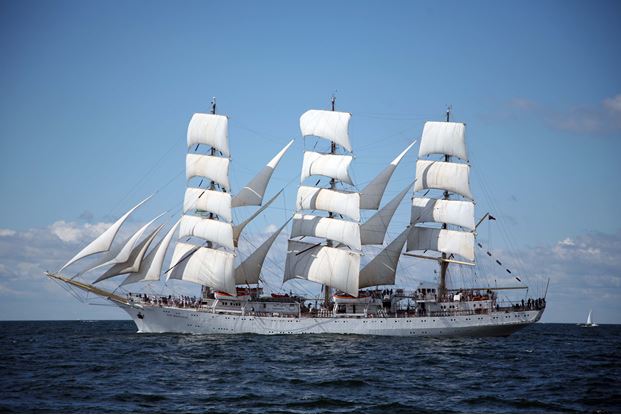
The year was 1976, the 200th anniversary of the birth of the United States. The Tall Ships of the world were in a sailing race to Newport Rhode Island. This ship, the Dar Parmorza was the leader as she was nearing Newport. It was reported later, the captain of the Polish ship received a message from the Russian ship. The message was short. It said, “Your ship will finish second!”
Russia at that time was causing serious world problems, not the least of which was impacting Poland. The Dar Parmorza finished the race in second place.
Days later, when the Tall Ships were anchored in the Newport harbor, my wife, Edie and I, Shirley and Russell Harmon, the Mayor of Fall River and his wife and a few others were invited to the Polish ship Captain’s party aboard that beautiful ship. I should add it was so foggy in the Newport harbor that afternoon you could hardly see any of the dozen or more Tall Ships from the shore in Newport.
At the Captain’s party there was an open bar with many bottles of liquor with labels none of us could read and small sandwiches, unfortunately so wet from the fog they were nearly impossible to pick up and eat.
I should add here that as the party grew longer, it got fogger and fogger. Some of it caused by the weather, but a lot of it caused by the bar. Because of this I found out the next day that I went home early.
I was told several of the young Polish sailors put me in a rowboat and rowed me to shore. And then my lovely wife drove me home to Somerset, Massachusetts. I was also told those that did not leave the party early were treated to a training film, usually shown to the new sailors. To quote my friend Russ, “I was the lucky one, I missed the film.”
Anyway, it was another great experience Edie and I shared. We loved it. Here we are pictured on the ship.
A few days later all the Tall Ships continued to the New York Harbor for a tremendous birthday party for the United States that many of us saw on television for the Fourth of July.
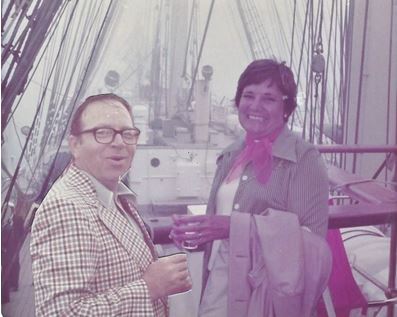
Dennis and Edie Orvis on the Dar Parmorza Tall Ship 1976
*****
The Mexican Hat Dance
By
Dennis C. Orvis
Ta, da da, Ta, da da, Ta da da!
The familiar beat of the song, The Mexican Hat Dance. I’ve heard it many times over the years.
But there was a time, perhaps the first and last time I heard it and danced the dance.
I was in the sixth grade of Lincoln Elementary School in Waterloo, Iowa. It was a class music project to learn and perform this particular dance. You can bet we heard it many times before our teacher decided we knew it well enough to actually dance.
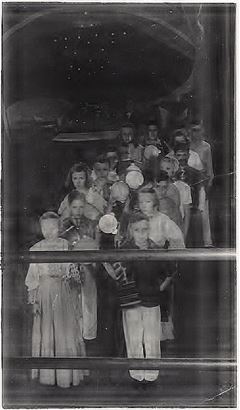
In this picture, taken in 1941, that is me and Juanita Dale, the second couple from the front. The first couple is her twin sister, Glenita and Jim McCleary. I can only remember two other names in the picture. One was Richard Deyo and the other was Robert Phillips. I don’t recall any of the others in the picture.
Along with the dance, I can add three other thoughts. First about Jim McCleary. He was a young happy Irishman. I think he was part leprechaun. We became great friends and because of him I came “out of my shell.” Together we were fun and mischief, often times in trouble with our teacher, Miss Merrill.
Secondly, about the Dale twins. Their father was a minister. I knew this although I never met him or their mother. Glenita was the happy one of the two. She laughed at or because of Jim and I frequently, on the other hand, Juanita was the somber one. She rarely laughed at either of us. And would you believe she was the one I really liked. Juanita was my first real crush, but I doubt she ever knew it. I certainly didn’t tell her. She would probably be surprised to know I said this. So you can understand how special it was for me to have her as my “senorita” in the dance. If you can look closely at the picture she isn’t smiling. You can also see most of the other dancers were not smiling either. And look at Glenita. She has a smile, a little faint, but she always had a smile.
Thirdly, about Miss Merrill. Most everyone has a favorite teacher. She was mine. She picked me to be one of the crossing guards. I got out of class about five minutes before the others, so I could get my “stop sign paddle” and go to my street corner. When the others were dismissed I would be on my assigned corner and I stopped the cars so all the students could safely cross the street.
Years later, ten years in fact, when I was living in Waverly Iowa, I was drafted into the army. It was February 1st, 1951. I was on a bus with about twenty others from my county on their way to
Des Moines, the capitol city to be sworn in to the army. We had to change busses in Waterloo to catch a bus to Des Moines. My mother and step father were there to see me. We didn’t get to see each other very often so this was pretty special.
I should add here that a few of the guys on the bus from Waverly had bottles of Peach Brandy in their travel bags. I really wasn’t a drinker, but why not, we’re going into the army. Frankly, I was a little tipsy when we stopped at the Waterloo bus station. I got through it fairly well, at least well enough to remember the occasion. As I left my mother and step father to go to the Des Moines bus, quite by accident I saw my old teacher, Miss Merrill. I stopped and we spoke for only a minute or two. I remember her saying, “Dennis I’m ashamed of you,” in her quiet tone.
I said, “I know, Miss Merrill, but I’m going into the army and I might not get back.”
She replied, “Dennis, I hope you get back.” Then we said goodbye. I did, Miss Merrill, I did and I thank you for everything, including your hope for me.
Ta, da da, Ta, da da, Ta, da da. That was sixty-one years ago today!
February 2012
*****
THE TIN GOOSE
By
DENNIS C. ORVIS
This is a true story, written especially for our three children, Vicki, Chuck and LeAnn.
In 1962, not long after we moved to Chariton, Iowa, there was an antique airplane show in Ottumwa, Iowa. This we learned was an annual event. Ottumwa was about fifty miles from Chariton.
Vicki was probably eight, Chuck was six and LeAnn was four, about to be five years old.
We went to the antique airplane show and the star of the show was a Ford Tri-motor. This was the first passenger plane ever built and it had a nickname, the “Tin Goose”. The owner of the plane was selling rides for five dollars per person. The sky was gray, but it was quite dark in the west. It looked like rain and the wind was picking up. It was also late in the afternoon.
The person selling the tickets announced that the next ride would be the last for the day. I asked him how much for our family of five to ride. He looked at us and said “Fifteen dollars if you hold the two smaller ones on your laps.”
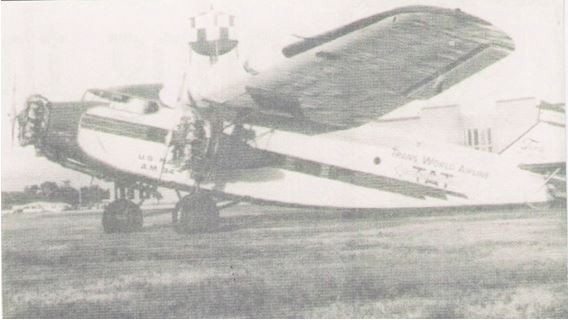
The Tin Goose only held seventeen passengers, if my memory is correct. We got on the plane. Mom held LeAnn and I held Chuck. The picture (attached) does not show it very clear, but there were side windows that are positioned on the dark strip on the side of the plane.
Obviously, the seats on a plane built in l929 (the year I was born) were not big and soft as they are today. From our seats, we could see the two pilots through an open doorway to the cockpit. We could also see the two motors (exposed) hanging under the wings, one on each side. There was a third motor in front of the pilots. Tri-motor means three motors.
Above the pilot’s heads, there was a crank that they turned by hand to control the wires that moved the tail flaps. This action made the plane go up and down and move to the right or left. I believe the top speed for the Tin Goose was sixty-five to seventy-five miles per hour. That may seem fast for a car, but for an airplane it is very slow.
As the plane took off, the clouds from the west were dark blue and you could tell a storm was coming. The plane ride was actually just a large circle around the edge of the town of Ottumwa. We took off into a west wind. Taking off into the wind was the easiest way to fly especially in the early days of flying. Older planes almost always took off into the wind.
It was kind of bumpy as there were many air pockets in the wind. Every time we hit an air pocket, Chuck would tighten up all his muscles and get very rigid on my lap. The exposed engines threw an oil spray that quickly covered all the side windows so everything looked hazy.
Flying into the wind made it feel like the plane was just sitting in the air, not moving. Of course the head wind was slowing the plane down. The pilots were turning the overhead crank all the time, as the winds were getting stronger. I suppose we were about a thousand feet in the air, maybe a little more.
As the pilots kept turning the plane in the counter-clockwise circle to their left, the wind direction moved from a headwind to blowing on our right side, which we could really feel. Then as we turned some more, we now had a tail wind and we must have gained at least twenty miles an hour. Then our final turn and we landed. The whole ride probably did not last more than five or ten minutes. It was starting to rain as we got out of the plane.
I don’t know how much of this you remember, but I believe the same plane you rode in is still giving “rides” around the country. You did not ride in the in the one pictured here. But your plane was in Lakeland in 1995 at the Sun N’ Fun air show, which is an annual event in Lakeland, Florida.
The rides in 1995 were twenty-five dollars per person.
It is hard to believe we did this as a family thirty-four years ago. But you did, in fact, take a ride in a Tin Goose, a Ford Tri-motor, airplane.
Maybe some day your children will have the same “great” experience.
This was one of the many special things we did together.
Love you, Dad.
Written March 1996
P.S. Today, April 11, 2014, the front page of the Lakeland Ledger newspaper has a story about the Ford Tri-Motor airplane. It was again at the Lakeland annual air show. Rides on the plane built in 1929 were $75 each.
*****
One Day at Sweet’s Marsh
By
Dennis C. Orvis
My good friend, Jack, recommended a non-fiction book to me recently. It is called Old Songs in a New Café, written by Robert James Waller.
You might recognize his name. He wrote the very popular book, The Bridges of Madison County, that later became a well-received movie starring Meryl Streep and Clint Eastwood.
This Waller book, Old Songs in a New Café, is a collection of essays. Waller is not only a
A fellow Iowan, but he is from northeast Iowa where I was born and spent much of the first thirty-three years of my life. Consequently, nearly every town and area he mentions in this book is quite familiar to me.
One of the essays is titled An Incident at Sweet’s Marsh. Reading this essay brought back a memory to me from the late 1950’s. I have only been to Sweet’s Marsh one time. It is a state owned Public Wildlife Reserve, located near the small town of Tripoli, Iowa. Tripoli is pronounced Tripola, with a small I and a small a by the people of Iowa. Tripoli is about twenty miles from Waverly, my hometown.
During duck hunting season each year, the State allows a limited number of duck hunters to hunt in a specified area of Sweet’s Marsh. State officials, Game Wardens, are at the gate of Sweet’s Marsh during hunting season to count the number of hunters and close the gate when the established number of duck hunters is reached. And obviously, they also patrol the area.
I only hunted ducks one time at Sweet’s Marsh and as I said it was the only time I was ever there. Now, with this background information, I will tell you about my One Day at Sweet’s Marsh.
There were three of us. My friends with me that day were both named Bob. One was a big guy. I’ll call him Big Bob. The other one I will call Bob H.
Big Bob drove. It was very dark when they picked me up at my house. In those years, the daily duck hunting season started one-half hour before sunrise and closed one-half hour after sunset. We knew we had to be at Sweet’s Marsh early to be included in the total hunters for the day before the gate is closed.
The twenty mile trip did not take long. It was still dark when we arrived. We figured we would be early enough to be included and we were.
We checked in and driving with only our parking lights on we slowly found the parking area. We unloaded our gear, which included our chest-high waders. We needed them to cross a small stretch of water in order to reach the island where the designated shooting areas were located.
We put the waders on and then, still in the darkness of early morning, we followed a worn path that became an earthen dam between two areas of the marsh. We were told by the Game Warden that the marshy area on the right of the dam was a protected part of the reserve. Hunters were not even allowed to point and/or shoot in that direction. Any hunter that did would be charged and fined.
Walking along this elevated earthen dam we could hear ducks quacking on the right side of the dam. There were no ducks quacking on the left side, which was the hunting area. How did they know they were protected on the right side? I’m sure that is one of Nature’s secrets.
It was somewhat difficult walking in our rubber chest-high waders along the uneven ground, but we struggled on with eager anticipation of good hunting later. Within five minutes we reached the place where we were to cross the stretch of water to the island.
Both Bobs had hunted here before, so I was following them.
It was still slightly dark when we entered the water, which was a little over knee deep. Somehow and I don’t know how, I must have been wading at an angle and not in a straight line behind them. As I said it was slightly dark.
Suddenly, I was up to my shoulders in the water! I had stepped into a hole! By instinct I raised my twelve-gauge shotgun above my head as I called out to the Bobs. The water was above my chest waders and the water quickly filled my waders! It was like standing in wet concrete! This is a very serious concern for duck hunters and the main reason why they should never hunt alone.
There was nothing I could do, but try and stand upright. If I would fall over, I would surely drown, as I simply could not move my feet or my body in that water casing.
The two Bobs were close to the island and quickly dropped their gear on the shore and returned to help me. It took both of them to pull me out of my waders and then get my waders out of the hole. I give them credit for saving my life.
Once on the island I soon felt I would freeze to death. It was fall in Iowa. The air and the water were both very cold in this early morning. I was wet, my clothes were wet and there was no place to get dry. Together the three of us trudged to our assigned hunting area. Fires were not allowed. I knew it was going to be a very, very long and cold day, for me for sure. A cup of coffee from my thermos did not help very much, but it did help.
The sunrise time was posted near the dam, so we knew when we could begin shooting in case
any ducks came our way.
The horizon was getting lighter. Minutes later we did not need a watch. A number of shotgun bursts boomed like a hunter’s crazy alarm clock. The duck hunting season for the day started.
We did not see any ducks in the air, nowhere. We couldn’t imagine what anyone was shooting at.
And I was very cold. I was hoping the morning sun would rise quickly with some warm air. When the sun did rise, it was no warmer to me than before. I was too wet and too cold to notice any difference.
Any visions of many flying ducks we might have had yesterday or when we planned this hunting trip to Sweet’s Marsh were nothing more than high hopes. About mid-morning, nearly five hours after we arrived in the dark, a small flock of Mallard ducks came our way. Bob H. fired first and the third duck in the formation fell to the ground near us.
He went to get the duck. When he returned one of the Game Wardens had come to our assigned area and met him.
The Warden said, “That was a pretty unlucky shot. You hit the only Redhead duck in the flock!”
It was against the law to shoot Redheads that year. The Warden took the duck and gave Bob H. a twenty-five dollar fine for shooting a Redhead out of season.
As if the day wasn’t already dreadful, from that moment on it continued to go downhill. Maybe a hundred yards or more across the marsh area from us, some jerk started shooting at ducks and geese when they were far out of range. Those shots would turn the birds and they would go somewhere else. It ruined any hunting for every hunter in the marsh.
Throughout the day, about the only ducks we saw were singles that slipped into the protected area, a direction, which you will recall, where we were not allowed to shoot. We still wondered how the ducks knew it was a protected area.
It was a disgusting day. A few hours before sunset, we gave up and backtracked our way from the island to the parking lot. It was stressful, putting my wet waders back on, but the rocky bottom of the water made it necessary. This time I was more careful, but it was easier to follow the two Bobs in the daylight.
Walking across the earthen dam to the parking lot we saw and heard hundreds of ducks in the protected area. I didn’t have to be there to know that when the hunting season closed at the end of the day, those ducks probably flew into the “hunting area” to eat. They probably knew they would be safe there after the daily hunting season closed.
Nature is good at what it does.
I don’t know if any hunter that day at Sweet’s Marsh shot any ducks, except Bob H. That Redhead was the only duck I saw fall. It was an expensive day for Bob H. Big Bob didn’t get anything either, except my thanks for pulling me out of my chest-waders in that deep hole.
I fully expected to get pneumonia, but somehow, I did not. Perhaps I suffered enough being wet and cold all day long.
So that is my story of One Day at Sweet’s Marsh. As bad as it was, I am fully aware it could have been much worse. That hole could have been two feet deeper.
I guess it was just one more of those strange things for which we can be thankful and I certainly was and still am.
When I think about what might have been, a tragedy with me drowning at Sweet’ Marsh in the dark of a cold fall morning, I cannot help but think the good Lord had a greater plan for me. I didn’t know it then, but today I believe it without hesitation.
I think of all the fine people I would not have met and the challenges I would never have known or the wonders of our great land I would not have seen. I think, more importantly, of my family
and of our children and the grandchildren that followed. Today I think of the many, many blessings I have enjoy and shared.
It reminds me even today, how blessed I really have been.
It was but One Day at Sweet’s Marsh, but it could have been a lifetime ended too soon.
Fortunately, for me, it wasn’t.
February 2008
*****
Fill the void!
By
Dennis C. Orvis
I have had friends tell me they like my writings and hove often added, “I wish I could do that!”
Now I would like to follow up on that statement by saying, “why not?” You see I believe if you can write your name, you can write your thoughts and memories.
You don’t have to be a great writer to put your thoughts on paper. Do you realize you are the best authority on you today?
I was blessed in that I knew my four grandparents, but I know nothing about them beyond their names, their children and some of the places where they lived. Until recent years I didn’t know where they came from or their ancestors.
This is the void in my life as there will be a void in the lives of your children and grandchildren and all that follow, if you don’t fill that void.
You can prevent that void of their life if you will only write it down, now.
You have story to tell… sure you do, everyone does. Everyone has a story about his or her life. It isn’t really up to you to decide if your life is interesting or not. I guarantee it will be interesting, someday to your children, grandchildren and great grandchildren.
Why not start today? Take time. Make time. What is the earliest you remember? Write it down. Write what you remember about your parents and grandparents and greats if you can. It is important to all that follow.
Too many people, most of them, nearly all of them take “all this knowledge” with them when they leave the living. It is a void that can never be filled, if you don’t fill it.
I wish my ancestors had filled it for me. So try it..go ahead and try it. I think you will be amazed at how much you remember as memories trigger memories and the past comes alive once again. And those that follow you will be delighted.
Go ahead, fill the void. Don’t wait any longer.
Best,
Dennis
P.S. It will be ok if you let me know you have started
*****
The President’s Limo
By
Dennis C. Orvis
It is January 22, 2009. The news media is talking about the first one hundred days of the new President, Barack Obama’s term. I am reminded that before his first one hundred days are over, I will celebrate the 30th anniversary of a Presidential event of my own.
It happened in April of 1979. My wife, Edie and I were in Washington D.C. attending the annual meeting of the U.S. Chamber of Commerce. It is usually held the last weekend of April and also usually, but not always, the cherry trees are in bloom. Washington is extra beautiful when that happens.
Bill Torpey, who was the Chamber’s volunteer President and his wife, Agnes were attending the U.S. Chamber event with us.
I was quite surprised and pleased when Bill told me that Agnes’ brother was in charge of the President’s limos! He also said we could tour the Presidential garage if we could work it into our schedule. I told him we could do it for sure and on one of our three days in Washington we took that tour.
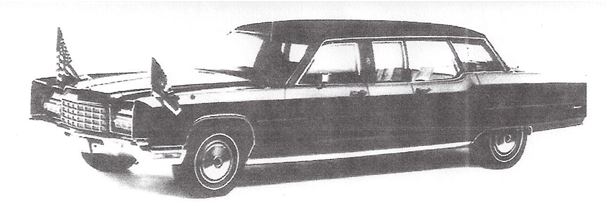
What a thrill it was! Her brother showed us the various limos and told us a few of the “limo” stories. One in particular I remember was that President Lyndon Johnson had microphones installed in the fenders so he could hear what people “outside” were saying. Another one he told us was about President Carter. When inflation was so high during his term he would not allow the limos to be “flown” to wherever he had to be. The limos had to be “trucked” because it cost less to truck them. He said it was a nightmare to get the limos to where they had to be and be on time for the President’s use. We saw how the secret service protected the President when in the limo and the tools they used. It was kind of a James Bond for sure.
And then the real thrill. Edie and I got to sit in the President’s limo! While sitting there for a few minutes, I thought, “What are the odds that this boy from Iowa and this girl from Georgia would be sitting in the President’s limo?” Well, the odds are beyond comprehension.
That was over thirty years ago. What a fantastic experience and it seems like yesterday. Imagine, President Obama was only seventeen years old at that time! As I watched the inauguration activities on television last week, it all came back to me once again. Of course, the limo President Obama is riding in is new. I don’t know if “my” limo from 1979 is still in the fleet or retired.
But my memory of it that day, that moment, will never retire.
January 23, 2009
*****
